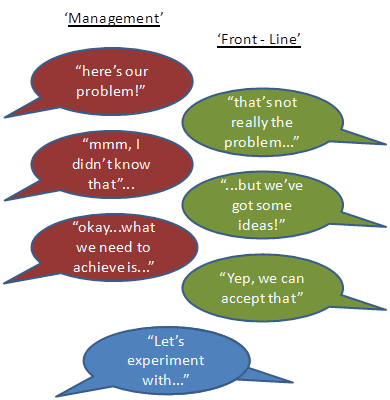 I wrote in my bio of Russell Ackoff that he was a favourite giant of mine…but I haven’t covered much of his work in my writings to date. I recently re-read a couple of chapters from his wonderful ‘Ackoff’s Best’ collection of essays on management (and education) and this post is the result.
I wrote in my bio of Russell Ackoff that he was a favourite giant of mine…but I haven’t covered much of his work in my writings to date. I recently re-read a couple of chapters from his wonderful ‘Ackoff’s Best’ collection of essays on management (and education) and this post is the result.
Ackoff wrote that:
“There are four ways of treating problems: absolution, resolution, solution and dissolution.
1. To absolve a problem is to ignore it and hope it will go away or solve itself;
…and how much of what occurs around us (in whatever organisation) fits into this category?!
2. To resolve a problem is to do something that yields an outcome that is good enough, that satisfies. Problem resolvers…try to identify the cause of a problem, remove or suppress it (relying on ‘experience’ and ‘common sense’), and thereby return to a previous state;
…this fits with a ‘copying’ what you or others have already done, and an ‘implementation’ mentality. Nothing’s really been solved, just hidden or worked around;
…to my mind ’outsourcing’ fits here: i.e. the hope that ‘giving the problem to someone else’ to sort out for you is a good idea. (There’s a post ‘shouting to get out’ here)
3. To solve a problem is to do something that yields the best possible outcome, that optimises. Problem solvers…rely heavily on experimentation and analysis;
…we may therefore move forward in a continuous and incremental manner
…but, whilst ‘solution’1 is a word that we all seem to be devoted to:
– no problem ever stays ‘solved’ due to the dynamic nature of reality; and
– every solution creates new problems. If you doubt this then reflect on the phrase that ‘Systems bite back’!
4. To dissolve a problem is to eliminate it by redesigning the system that has it [such that the problem no longer exists]. Problem dissolvers try to idealise – to approximate an ideal system – and thereby do better in the future than the best that can be done now.
…this is to look at the ‘problem’ within its context – the bigger system that it sits within; to go ‘above’ the problem and look to understand how and why it exists in its wider environment;
…and, by redesign, achieve breakthrough improvement (or in Ackoff’s words a “discontinuity”).
Some ‘command and control’ organisational examples
…to ponder in respect of problems and their (re)solutions:
- Why do we try to continually draft, and redraft cascaded personal objectives in the hope that we can make them SMART and good for the stated purpose of the system?
- Why do we try to continually redesign our performance management system in the deluded hope that it finally becomes ‘fair’?
- Why do we continue to fiddle with the incentives system so as to ‘motivate’ our people to ‘do what we want’, whilst increasing ‘controls’ to stamp out the resultant undesirable dysfunctional behaviour?
- Why do we constantly strive to ‘give’ people empowerment (which is an oxymoron) and ‘make them’ engaged with their work, and yet continue to command and control what they do?
…why don’t we look at the management system (which reflects management’s beliefs and behaviours) that currently requires cascaded personal objectives, targets, the rating of people and the dangling of contingent rewards…and redesign it …and thereby dissolve these recurring ‘problems’?!
(Clarification: A reorganisation does NOT qualify as redesign!)
So how do we redesign?
You study your system, get knowledge and then, and only then, intervene for the good of your employees and customers….which sustains a long-term result for your investors.
But you don’t simply ‘intervene’: The manner of your intervention is vital to the outcome.
In a recent post, ‘Think Purpose’ brilliantly explained a somewhat profound point – that “change doesn’t happen AFTER finding the solution, it IS the solution.” His post (along with the simple yet insightful diagrams within) is worth taking the time to read.
Looking at what is written above, I see a strong correlation between dissolving problems and people understanding and improving their system for themselves.
Okay, so we’ve looked at different ways to treat a problem but…
What’s a problem anyway?
Ackoff went on to explain that:
“There’s no such thing as ‘a problem’. They don’t exist – they are a concept. A problem is an abstraction, extracted from reality by analysis. It’s isolated from reality.
A problem is to reality what an atom is to a table: You experience tables not atoms – you experience the whole, not the parts that you have reduced it to by conceptual reduction.
What we experience (i.e. reality) are dynamic situations that consist of complex systems of problems, not individual or isolated problems. I call such systems messes.
When a mess, which is a system of problems, is taken apart, it loses its essential properties, and so does each of its parts. The behaviour of a mess depends more on how the treatments of its parts interact than on how they act independently of each other.”
“Erm, right…I think – got any examples to illustrate?”
Okay, I’ll go with two topical examples in the news.
Let’s start with Donald Drumpf3:
 Problem: (supposed hoards of) illegal Mexicans
Problem: (supposed hoards of) illegal Mexicans- Resolution: Build a wall! Obvious really :).
- So how will that help? If you want a hugely funny take-down of Donald’s overly simplified problem-resolution thinking, watch John Oliver’s hilarious 18 min. piece about how determined ‘aliens’ will easily get around the wall. The bit where Donald answers his own question by suggesting they might just use a rope to lower themselves down is hilarious.
I could have written all day about other absurdly simplistic Drumpf-isms to everything and anything but, frankly, he’s too easy a target. What comes out of his mouth are supposed ‘resolutions’ to problems without thinking about the mess from which they come….and the many many new problems that they will spawn.
Without wanting to be political, I would note that Bernie Sanders appears to look underneath the problems at the systemic root causes, with a huge desire for redesign.
And so on to ‘BREXIT’:
 On 23rd June 2016 Britain votes on whether to remain in or leave the EU.
On 23rd June 2016 Britain votes on whether to remain in or leave the EU.
The ‘problem’ that the leaders of the ‘Leave’ campaign appear fixated on is the control of (supposedly unmanageable) immigration…mmm, there’s a similarity with Drumpf here.
Now, I’m not saying that leaving the EU is impossible – of course it’s not…but I believe that the suggested miracle ‘cure’ of leaving the EU is many magnitudes worse than the abstract ‘problem’ of resolving immigration.
An attempt at ‘dissolving’ the problem might look at why they want to leave their homes. Bombs could have something to do with it.
(If you don’t mind the swearing – I warned you – then I love this 3 min. Jonathan Pie ‘BREXIT’ video)
So what about an organisational example to end on?
Resolving the problem of high costs by ‘cost-cutting’ fits here!
We should remember that “Costs aren’t causes. Costs come from causes.” (Deming).
We can’t look at a line item in the management accounts, say it is too high and command that it be cut…and then not expect this to harm the system. The abstract ‘problem’ of a (seemingly) high cost cannot be separated from the system that causes it.
Ackoff’s ‘mess’ thinking now makes so clear the underlying reasons behind Seddon’s message:
“Managing value [i.e. the purpose of the system] drives out cost.
Cost cutting [i.e. an abstract ‘problem’] paradoxically adds costs, and harms value.”
To conclude
Here’s the hugely important point in a final Ackoff quote:
“A partial solution to a whole system of problems is better than whole solutions of each of its parts taken separately.”
- A partial solution for the whole is good for the system’s purpose, and can be improved yet further as we study and learn more;
- ‘Whole solutions’ to each part will likely harm, and can ultimately destroy, the system and its purpose.
Or, in American-speak:
- A small step towards gun control is better than arming everyone4;
- A small step towards cultural, racial and religious tolerance/integration is better than building a wall and throwing people out of the country.
Neither of these small steps eradicates the mess, but both start to untangle it.
Notes:
- Many ‘Lean (Systems) Thinkers’ prefer to use the word ‘countermeasure’ rather than ‘solution’ because they understand the reality of a complex and dynamic system;
- If you are new to this blog and don’t appreciate what the word ‘system’ means then please take the time to enlighten yourself – this is foundational to everything;
- If you don’t know why I’m calling Trump ‘Drumpf’…John Oliver provides the answer 🙂
- Here’s Donald Drumpf’s simplistic rationale on arming the ‘good guys’ (who ever they may be!): “[the recent massacre in Paris] would have played out differently with the bullets flying in the other direction.”
- I’ve always intensely disliked the rather conventional ‘go after the low hanging fruit’ business improvement phrase, which refers to taking a cursory glance at something, coming to some quick judgements and ‘wading in’ with solutions. The phrase “Don’t think about it, just do it” springs to mind! Ackoff’s brilliant systems thinking work firmly puts the ‘low hanging fruit’ mentality in its place (at least for me anyway).
 So my son had some school exams and this post was triggered from a conversation I had with him just afterwards:
So my son had some school exams and this post was triggered from a conversation I had with him just afterwards: There should be no surprise if the workers are merely clocking in, turning the wheel, collecting their pay and going home again. It’s what people end up doing when they are kept in the dark….though they likely didn’t
There should be no surprise if the workers are merely clocking in, turning the wheel, collecting their pay and going home again. It’s what people end up doing when they are kept in the dark….though they likely didn’t  However, ‘visual management’ should have a whopping big warning message plastered all over its box, that people would have to read before undoing the clasps and pushing back the lid…because visual management works for whatever you put up on the wall!
However, ‘visual management’ should have a whopping big warning message plastered all over its box, that people would have to read before undoing the clasps and pushing back the lid…because visual management works for whatever you put up on the wall! Catch ball: Participative approach to decision-making in which information and ideas are thrown and caught back and forth, up and down throughout the organization”
Catch ball: Participative approach to decision-making in which information and ideas are thrown and caught back and forth, up and down throughout the organization” A solution to a hypothetical/ ideological/ management perceived problem is proposed and released ‘for consultation’;
A solution to a hypothetical/ ideological/ management perceived problem is proposed and released ‘for consultation’; “Consensus does not mean that everyone agrees – that would be impossible.
“Consensus does not mean that everyone agrees – that would be impossible.  The truth – can you handle it?
The truth – can you handle it?